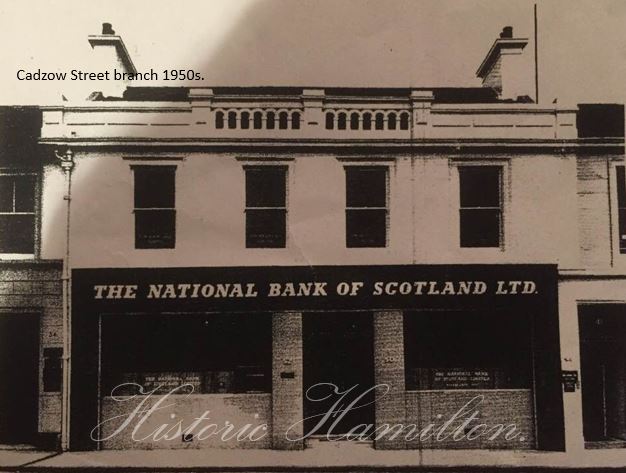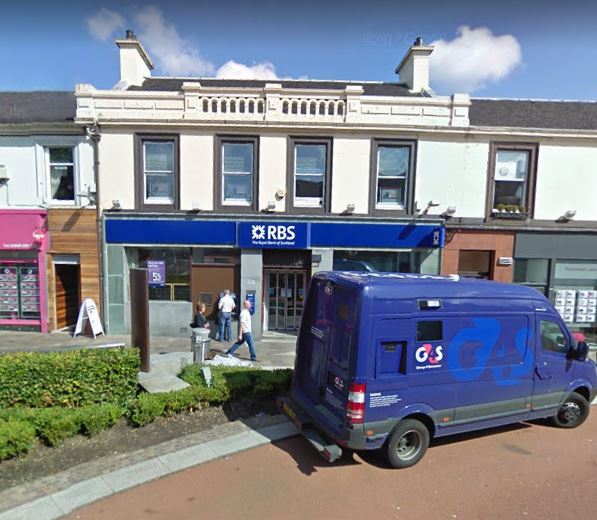
THE ROYAL BANK OF SCOTLAND TO CLOSE.
It has been announced that the Royal Bank of Scotland is to close 62 of its branches throughout Scotland. Our branch which has stood in Cadzow Street for 115 Years has been confirmed as one of these branches. The new age digital world of online banking has brought the demises of high street banks and for this reason, Cadzow Street will lose an old familiar shop.
Hamilton Cadzow Street branch opened as an office of the National Bank of Scotland in October 1902. Hamilton at that time was already a thriving and important town with a population of around 7,600 people. Serval successful decades of coal mining brought considerable wealth to the area, as shown in the numerous fine buildings which were erected in Hamilton and particularly in Cadzow Street around the turn of the twentieth century.
The bank agreed to open a branch in the town at the request of William Dykes Loudon who was a local solicitor and town councillor, who believed that Hamilton could provide enough banking business to support another branch, in addition to the several which were already open in Hamilton.
National Bank of Scotland had been founded in Edinburgh in 1825 with more shareholders than any other bank in Britain. By the beginning of the twentieth century, it was operating around 125 branches in Towns and Villages throughout Scotland.
National Bank’s Hamilton branch first opened on the 20th of October 1902, with William Loudon himself as its agent. In its early years, the branch operated from Hamilton’s Masonic halls, originally near the bottom of Cadzow Street and Lower Auchingramont Road.
Just as William Loudon and the Bank’s directors had expected, the new branch was an immediate success. It was located in a thriving area of the town, with trams beginning to run along Cadzow Street in 1903, and the impressive new Municipal Buildings being opened in 1907.
Nevertheless, difficult times were on the horizon when the first world war broke out in 1914, the banking industry found itself facing new challenges. Levels of trade were reduced, money market rates were low, and staff shortages became severe as many Bank clerks of military age enlisted. William Loudon and two members of his staff from the Cadzow Street branch were among 439 employees of the National Bank of Scotland who left their posts to join the war effort.
After the war, business returned to normal, but Hamilton itself was changing. The coal mining industry had been severely affected by controls on exports and a shortage of workers during the war, and it never again returned to the levels of productivity that it had experienced at the turn of the century. Numerous Pits in the area were closed during the 1920s and 930s.
When the second world war began in 1939 the Banks resumed the special duties which governed their activities in wartime. Five men from the National Bank of Scotland’s Cadzow Street branch left to join the war. Meanwhile, the premises of the branch were also undergoing a change wherein 1942, the bank bought the site of 50 Cadzow Street and set about preparing it for use as a bank branch.
In fact, this was not the first time that 50 Cadzow Street had housed a Bank. In the 1860s and 1870s, the building had been owned by the Hamilton branch of the City of Glasgow Bank. This bank collapsed with huge debts and much publicity in 1878, leaving many of its shareholders, including serval citizens of Hamilton financially ruined. (Lewis Potter of Udston House in Burnbank was one of the men who went to prison as a direct result of the collapse of the Bank.)
In the early years of the twentieth century, the building had been occupied by a branch of Mercantile Bank of Scotland. More recently it had served as a shop of Peter Wyper & Sons but by the end of the war 50 Cadzow Street had become a bank once more and National Bank of Scotland’s Hamilton Brach was, at last, the sole occupant of premises of its own.
The Cadzow Street branch continued to trade successfully throughout the 1940s and 1950s, as new industries moved into the area replacing the old coalmining jobs. New housing was also built around the Town.
In 1959, the National Bank of Scotland merged with the Commercial Bank of Scotland, and 50 Cadzow Street branch became part of the National Commercial Bank of Scotland. In 1969 another merger occurred, this time between the National Commercial Bank of Scotland and the Royal Bank of Scotland. The new bank, with 693 branches enjoyed over 40 percent of Scottish Banking business.
The Royal Bank of Scotland now found itself with three branches in Hamilton, all located on Cadzow Street, there was the old National Bank at number 50, a former Commercial Bank Branch at number 88, and the original Royal Bank Branch at number 105. All three branches remained open, although the branch at 88 Cadzow Street was relocated in 1972 to Duke Street, in order to give a better geographical coverage of the town, particularly in the growing shopping area.
The branch at 50 Cadzow Street remained in its own premises and in 1980, a cashline machine was installed for the first time. The interior of the premises was also refurbished in the early 1980s and again in the mid-1990, but the exterior remains as much as it did when the branch first opened here in 1902. The branch absorbed the business of 105 Cadzow Street branch upon its closure.
Today and 115 years after it first opened its doors for business, Hamilton’s Cadzow Street branch continues to offer a full range of Banking services to our community, but for how long?
